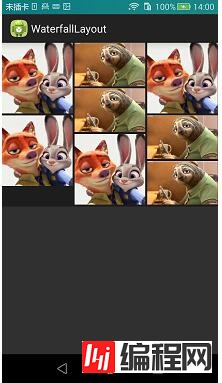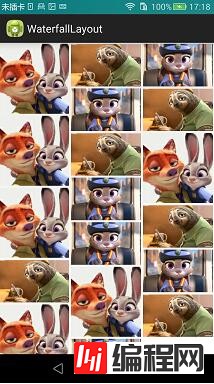上一篇我们学习了自定义ViewGroup的基本步骤,并做了一个CustomGridLayout的实例,这篇我们继续来说说自定义ViewGroup。 Android中当有大量照
上一篇我们学习了自定义ViewGroup的基本步骤,并做了一个CustomGridLayout的实例,这篇我们继续来说说自定义ViewGroup。
Android中当有大量照片需要展示的时候,我们可以用GridView作为照片墙,但是GridView太整齐了,有时候不规则也是一种美,瀑布流模型就是这样一个不规则的展示墙,接下来我们尝试用自定义ViewGroup来实现瀑布流。
实现瀑布流的方式也有很多,下面我们一一道来:
一、继承ViewGroup
其实这种实现方式我们只需要在上篇博客的基础上稍作修改即可,主要修改这几个地方:
•LayoutParams
因为瀑布流中每张图片宽度设为相同,高度则会不同,不能通过top加上固定高度得到bottom,所以这里我干脆把四个参数都定义上
public static class LayoutParams extends ViewGroup.LayoutParams {
public int left = 0;
public int top = 0;
public int right = 0;
public int bottom = 0;
public LayoutParams(Context arg0, AttributeSet arg1) {
super(arg0, arg1);
}
public LayoutParams(int arg0, int arg1) {
super(arg0, arg1);
}
public LayoutParams(android.view.ViewGroup.LayoutParams arg0) {
super(arg0);
}
}
•onMeasure
这里每个图片宽相同,高等比缩放,所以会导致WaterfallLayout的layout_height没有用。同时用一个数组top[colums]来记录每列当前高度,以便下次添加图片的时候添加到高度最小的那一列。
@Override
protected void onMeasure(int widthMeasureSpec, int heightMeasureSpec) {
int widthMode = MeasureSpec.getMode(widthMeasureSpec);
int sizeWidth = MeasureSpec.getSize(widthMeasureSpec);
measureChildren(widthMeasureSpec, heightMeasureSpec);
int childCount = this.getChildCount();
//宽布局为wrap_content时,childWidth取childView宽的最大值,否则动态计算
if (widthMode == MeasureSpec.AT_MOST) {
for (int i = 0; i < childCount; i++) {
View child = this.getChildAt(i);
childWidth = Math.max(childWidth, child.getMeasuredWidth());
}
} else if (widthMode == MeasureSpec.EXACTLY) {
childWidth = (sizeWidth - (colums - 1) * hSpace) / colums;
}
//自定义View的onMeasure、onLayout会执行两次,为了以后执行得到正确的结果
clearTop();
//遍历每个子view,将它们坐标保存在它们的LayoutParams中,为后面onLayout服务
for (int i = 0; i < childCount; i++) {
View child = this.getChildAt(i);
childHeight = child.getMeasuredHeight() * childWidth / child.getMeasuredWidth();
LayoutParams lParams = (LayoutParams) child.getLayoutParams();
int minColum = getMinHeightColum();
lParams.left = minColum * (childWidth + hSpace);
lParams.top = top[minColum];
lParams.right = lParams.left + childWidth;
lParams.bottom = lParams.top + childHeight;
top[minColum] += vSpace + childHeight;
}
//当宽为wrap_content时,计算出的viewGroup宽高
int wrapWidth;
int wrapHeight;
if (childCount < colums) {
wrapWidth = childCount * childWidth + (childCount - 1) * hSpace;
} else {
wrapWidth = colums * childWidth + (colums - 1) * hSpace;
}
wrapHeight = getMaxHeight();
setMeasuredDimension(widthMode == MeasureSpec.AT_MOST? wrapWidth:sizeWidth, wrapHeight);
}
•onLayout
因为LayoutParams定义了View的四个参数,所以直接设置即可
@Override
protected void onLayout(boolean changed, int l, int t, int r, int b) {
int childCount = this.getChildCount();
for (int i = 0; i < childCount; i++) {
View child = this.getChildAt(i);
LayoutParams lParams = (LayoutParams) child.getLayoutParams();
child.layout(lParams.left, lParams.top, lParams.right, lParams.bottom);
}
}
这里有个地方需要注意一下,每次设置子View的LayoutParams前需要将top[]数组清零,因为onMeasure和onLayout会调用两次,这样就确保了下一次设置参数正确。
延伸:为什么自定义viewGroup中的onMeasure和onLayout方法会调用两次?
因为当我们new ViewGroup()的时候,通过getWidth()和getHeight(),得到的值首先是0,0,然后通过调用onMeasure()和onLayout()方法,会对这个view测量大小,这个时候view的宽高就发生了改变,这个时候又会重新调用一次onMeasure和onLayout方法(当view发生改变的时候,这两个方法会被调用),这时候你通过getWidth和getHeight方法就可以看到被测量之后的宽高了。这就是会调用两次的原因。
•点击事件回调
//点击事件的回调接口
public interface OnItemClickListener {
void onItemClick(View v, int index);
}
public void setOnItemClickListener(final OnItemClickListener listener) {
for (int i = 0; i < getChildCount(); i++) {
final int index = i;
View view = getChildAt(i);
view.setOnClickListener(new OnClickListener() {
@Override
public void onClick(View v) {
listener.onItemClick(v, index);
}
});
}
}
使用WaterfallLayout来添加图片:
<?xml version="1.0" encoding="utf-8"?>
<ScrollView xmlns:android="Http://schemas.android.com/apk/res/android" xmlns:app="http://schemas.android.com/apk/res/com.hx.waterfalllayout"
android:layout_width="match_parent"
android:layout_height="match_parent"
android:background="#303030"
android:orientation="vertical" >
<com.hx.waterfalllayout.WaterfallLayout
android:id="@+id/gridview"
android:layout_width="wrap_content"
android:layout_height="wrap_content"
android:background="#1e1d1d"
app:hSpace="10"
app:numColumns="3"
app:vSpace="10" >
<ImageView
android:layout_width="wrap_content"
android:layout_height="wrap_content"
android:scaleType="centerCrop"
android:src="@drawable/crazy_1" />
<ImageView
android:layout_width="wrap_content"
android:layout_height="wrap_content"
android:scaleType="centerCrop"
android:src="@drawable/crazy_2" />
<ImageView
android:layout_width="wrap_content"
android:layout_height="wrap_content"
android:scaleType="centerCrop"
android:src="@drawable/crazy_1" />
<ImageView
android:layout_width="wrap_content"
android:layout_height="wrap_content"
android:scaleType="centerCrop"
android:src="@drawable/crazy_2" />
<ImageView
android:layout_width="wrap_content"
android:layout_height="wrap_content"
android:scaleType="centerCrop"
android:src="@drawable/crazy_1" />
<ImageView
android:layout_width="wrap_content"
android:layout_height="wrap_content"
android:scaleType="centerCrop"
android:src="@drawable/crazy_2" />
<ImageView
android:layout_width="wrap_content"
android:layout_height="wrap_content"
android:scaleType="centerCrop"
android:src="@drawable/crazy_1" />
<ImageView
android:layout_width="wrap_content"
android:layout_height="wrap_content"
android:scaleType="centerCrop"
android:src="@drawable/crazy_2" />
</com.hx.waterfalllayout.WaterfallLayout>
</ScrollView>
这里最外层我们用的ScrollView,因为照片墙可以无限添加照片,为了让照片数量在超出频幕范围后可以滚动。还有这里ImageView都是在xml中写的,当然我们也可以在Java中向这个ViewGroup动态添加ImageView,而且代码更美观。
实现瀑布流图片的点击事件回调函数:
((WaterfallLayout) findViewById(R.id.waterfallLayout)).setOnItemClickListener(new com.hx.waterfalllayout.WaterfallLayout.OnItemClickListener() {
@Override
public void onItemClick(View v, int index) {
Toast.makeText(MainActivity.this, "item="+index, Toast.LENGTH_SHORT).show();
}
});
来看看运行效果:

延伸:
一般我们自定义的控件,嵌套在scrollview中会显示不全,这个问题很纠结,不过当你打开scrollview的源码,你会发现有一个地方,同时可以理解scrollview中嵌套viewpager,gridview,listview时候会显示不全的问题了。

这里有个小技巧可以让嵌套的viewpager,gridview,listview显示完全,譬如我们可以定义自己的OtherGridView继承Gridview,并重写onMeasure方法即可,其他ViewGroup同理:
public class OtherGridView extends GridView {
public OtherGridView(Context paramContext, AttributeSet paramAttributeSet) {
super(paramContext, paramAttributeSet);
}
@Override
public void onMeasure(int widthMeasureSpec, int heightMeasureSpec) {
int expandSpec = MeasureSpec.makeMeasureSpec(Integer.MAX_VALUE >> 2,
MeasureSpec.AT_MOST);
super.onMeasure(widthMeasureSpec, expandSpec);
}
}
二、继承ScrollView
继承ScrollView的瀑布流模型当图片过多需要滑动式不必在外面再嵌套一个ScrollView。
这时不需要重写onMesure,只需要重写onLayout
•onLayout
@Override
protected void onLayout(boolean changed, int l, int t, int r, int b) {
super.onLayout(changed, l, t, r, b);
if (changed && !loadOnce) {
firstColumn = (LinearLayout) findViewById(R.id.first_column);
secondColumn = (LinearLayout) findViewById(R.id.second_column);
thirdColumn = (LinearLayout) findViewById(R.id.third_column);
columnWidth = firstColumn.getWidth();
loadOnce = true;
loadImages();
}
}
•加载图片
public void loadImages() {
for (int i = 0; i < imageRes.length; i++) {
Bitmap bitmap = resource2Bitmap(imageRes[i]);
if (bitmap != null) {
double ratio = bitmap.getWidth() / (columnWidth * 1.0);
int scaledHeight = (int) (bitmap.getHeight() / ratio);
addImage(i, bitmap, columnWidth, scaledHeight);
}
}
}
private void addImage(int index, Bitmap bitmap, int imageWidth, int imageHeight) {
LinearLayout.LayoutParams params = new LinearLayout.LayoutParams(imageWidth, imageHeight);
ImageView imageView = new ImageView(getContext());
imageView.setLayoutParams(params);
imageView.setImageBitmap(bitmap);
imageView.setScaleType(ScaleType.FIT_XY);
imageView.setPadding(5, 5, 5, 5);
findColumnToAdd(imageView, imageHeight).addView(imageView);
//给图片添加点击事件的回调
imageView.setOnClickListener(new OnClickListener() {
@Override
public void onClick(View v) {
if (onItemClickListener != null) {
onItemClickListener.onItemClick(v, index);
}
}
});
}
private LinearLayout findColumnToAdd(ImageView imageView,int imageHeight) {
if (firstColumnHeight <= secondColumnHeight) {
if (firstColumnHeight <= thirdColumnHeight) {
firstColumnHeight += imageHeight;
return firstColumn;
}
thirdColumnHeight += imageHeight;
return thirdColumn;
} else {
if (secondColumnHeight <= thirdColumnHeight) {
secondColumnHeight += imageHeight;
return secondColumn;
}
thirdColumnHeight += imageHeight;
return thirdColumn;
}
}
到这里就可以显示瀑布流照片墙了,是不是很方便呢?但是这种方式也有局限性,譬如这里列宽被写死成3列了,没有很好的扩展性。
代码里我们并没有看到自定义ViewGroup实现每个childView的layout方法,那么childView是怎么布局的呢?其实childView的布局是通过LinearLayout来实现的,也就是说在LinearLayout内部调用了每个childView的layout方法,这是不是和之前我们讲自定义View时的组合控件很像呢?
findColumnToAdd(imageView, imageHeight).addView(imageView);
•定义图片点击回调接口
//点击事件的回调接口
public OnItemClickListener onItemClickListener;
public interface OnItemClickListener {
void onItemClick(View v, int index);
}
public void setOnItemClickListener(OnItemClickListener onItemClickListener){
this.onItemClickListener = onItemClickListener;
}
•使用ScrollWaterfallLayout
因为代码里指定了只有三列,所以xml需要三个水平摆放的LinearLayout
<?xml version="1.0" encoding="utf-8"?>
<LinearLayout xmlns:android="http://schemas.android.com/apk/res/android"
android:layout_width="fill_parent"
android:layout_height="fill_parent"
android:orientation="vertical">
<com.hx.waterfalllayout.ScrollWaterfallLayout
android:id="@+id/scrollWaterfallLayout"
android:layout_width="match_parent"
android:layout_height="match_parent" >
<LinearLayout
android:layout_width="match_parent"
android:layout_height="wrap_content"
android:orientation="horizontal" >
<LinearLayout
android:id="@+id/first_column"
android:layout_width="0dp"
android:layout_height="wrap_content"
android:layout_weight="1"
android:orientation="vertical" >
</LinearLayout>
<LinearLayout
android:id="@+id/second_column"
android:layout_width="0dp"
android:layout_height="wrap_content"
android:layout_weight="1"
android:orientation="vertical" >
</LinearLayout>
<LinearLayout
android:id="@+id/third_column"
android:layout_width="0dp"
android:layout_height="wrap_content"
android:layout_weight="1"
android:orientation="vertical" >
</LinearLayout>
</LinearLayout>
</com.hx.waterfalllayout.ScrollWaterfallLayout>
</LinearLayout>
实现瀑布流图片的点击事件回调函数:
((ScrollWaterfallLayout)findViewById(R.id.scrollWaterfallLayout)).setOnItemClickListener(new com.hx.waterfalllayout.ScrollWaterfallLayout.OnItemClickListener() {
@Override
public void onItemClick(View v, int index) {
Toast.makeText(MainActivity.this, "item="+index, Toast.LENGTH_SHORT).show();
}
});
运行效果:

源码下载:http://xiazai.jb51.net/201609/yuanma/Android-WaterfallLayout(jb51.net).rar
您可能感兴趣的文章:Android自定义ViewGroup之实现FlowLayout流式布局Android简单实现自定义流式布局的方法Android实现热门标签的流式布局解析在Android中为TextView增加自定义html标签的实现方法android配合viewpager实现可滑动的标签栏示例分享Android中使用include标签和merge标签重复使用布局Android开发常用标签小结android多行标签热点示例Android自定义ViewGroup之CustomGridLayout(一)Android自定义ViewGroup之FlowLayout(三)
--结束END--
本文标题: Android自定义ViewGroup之WaterfallLayout(二)
本文链接: https://www.lsjlt.com/news/23992.html(转载时请注明来源链接)
有问题或投稿请发送至: 邮箱/279061341@qq.com QQ/279061341
下载Word文档到电脑,方便收藏和打印~
2024-01-21
2023-10-28
2023-10-28
2023-10-27
2023-10-27
2023-10-27
2023-10-27
回答
回答
回答
回答
回答
回答
回答
回答
回答
回答
0